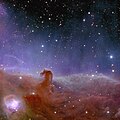File:Euclid’s view of the Horsehead Nebula ESA25170866.jpg

Dimensioni di questa anteprima: 600 × 600 pixel. Altre risuluzioni: 240 × 240 pixel | 480 × 480 pixel | 768 × 768 pixel | 1 024 × 1 024 pixel | 2 048 × 2 048 pixel | 8 200 × 8 200 pixel.
Imagine in alta resoluzione (8 200 × 8 200 pixel, dimensione del file: 1,84 MB, tipo MIME: image/jpeg)
Cronolugia di l'imagine
Fare clic su un gruppo data/ora per vedere il file come si presentava nel momento indicato.
| Data/Óra | Previsualizzazione | Dimensione | Cuntributore | Cummentu | |
|---|---|---|---|---|---|
| attuale | 18:50, 7 nuv 2023 |  | 8 200 × 8 200 (1,84 MB) | OptimusPrimeBot | #Spacemedia - Upload of https://www.esa.int/var/esa/storage/images/esa_multimedia/images/2023/11/euclid_s_view_of_the_horsehead_nebula/25170855-1-eng-GB/Euclid_s_view_of_the_Horsehead_Nebula.jpg via Commons:Spacemedia |
Ligami
Ùn ci hè micca pàgine chì utilìzanu ssu schedàriu.
Usu glubale di u schedariu
Anche i seguenti wiki usano questo file:
- Usu nantu à fr.wikipedia.org
- Utilisateur:Urban
- Discussion utilisateur:Ofol
- Utilisateur:Sammyday
- Utilisateur:Cimosteve
- Utilisateur:Fagairolles 34
- Wikipédia:Wikimag
- IC 434
- Utilisateur:Lynks/utilisateur
- Utilisateur:Hotep
- Utilisateur:Delhovlyn/Accueil
- Projet:Montréal/Infolettre
- Projet:Ville de Québec/Infolettre
- Modèle:Wiki magazine
- Projet:Acadie/Infolettre
- Utilisateur:Masterdeis
- Utilisateur:Armael
- Discussion utilisateur:Hlm Z.
- Discussion utilisateur:Lvcvlvs
- Euclid (télescope spatial)
- Utilisateur:Ambigraphe/Station
- Utilisateur:Azervh
- Utilisateur:Bolbec
- Utilisateur:Philippe rogez/Pages
- Projet:Louisiane/Infolettre
- Projet:Yukon/Infolettre
- Projet:Nunavut/Infolettre
- Projet:Territoires du Nord-Ouest/Infolettre
- Utilisateur:GaetanSpace
- Utilisateur:LoganEspeon
- Wikipédia:Wikimag/2020/35
- Utilisateur:MG/Page3
- Utilisateur:MG/Drapeaux
- Wikipédia:Image du jour/1 mai 2024
- Wikipédia:Wikimag/2024/18
- Wikipédia:Image du jour/mai 2024
- Usu nantu à he.wikipedia.org
- Usu nantu à ru.wikipedia.org




